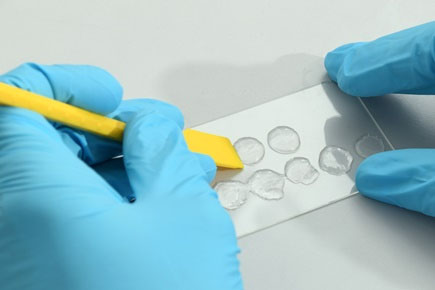| Apr 15, 2025 |
Researchers are developing a new hydrogel-based material that makes it possible to engineer artificial skin tissues, which can serve as living three-dimensional models of human skin for better understanding and treating skin diseases.
|
|
(Nanowerk News) The skin is the largest organ in the human body. It makes up around 15 percent of our body weight and protects us from pathogens, dehydration and temperature extremes. Skin diseases are therefore more than just unpleasant – they can quickly become dangerous for affected patients. Although conditions such as skin cancer, chronic wounds and autoimmune skin diseases are widespread, we often still don’t fully understand about why they develop and how we can treat them effectively.
|
|
To find answers to these questions, Empa researchers are working together with clinical partners on a model of human skin. The model will allow scientists to simulate skin diseases and thus better understand them. This is not a computer or plastic model. Rather, researchers from Empa’s Laboratory for Biomimetic Membranes and Textiles and its Laboratory for Biointerfaces aim to produce a living “artificial skin” that contains cells and emulates the layered and wrinkled structure of human skin. The project is part of the Swiss research initiative SKINTEGRITY.CH.
|
|
In order to recreate something as complex as skin, suitable building materials are needed. This is where Empa researchers have recently made progress: They have developed a hydrogel that meets the complex requirements while being easy to manufacture. The basis: gelatin from the skin of cold-water fish.
|
|
The research has been published in Materials Today Bio (“Mechanically robust non-swelling cold water fish gelatin hydrogels for 3D bioprinting”).
|
 |
| Gelatin from cold-water fish such as cod, pollock and haddock can be cross-linked in just a few steps to turn it into a non-swelling hydrogel, which can be printed with skin cells. (Image: Empa)
|
More than just cells
|
|
Like most tissues, the skin consists of cells that are embedded in a so-called extracellular matrix: a network of proteins and other biomolecules that provides the tissue with shape and structure and sustains the cells. The extracellular matrix differs from tissue to tissue – in the case of the skin even from layer to layer. It is crucial to use a suitable substitution for this matrix to engineer a representative skin model.
|
|
One way to simulate the extracellular matrix is to use hydrogels: special polymers whose chains are cross-linked in a way that allows them to absorb large quantities of water and other fluids. They are particularly suitable for simulating skin extracellular matrix that contains a large amount of water and other fluids. Another advantage: Many hydrogels can be processed using a 3D printer.
|
|
“3D printing is powerful for skin model development. The skin cells can be embedded in the hydrogel matrix in specific patterns and not at random,” says Kongchang Wei, group leader of the joint research group Tissue-Regenerative Soft Materials. “3D printing allows us to combine multiple materials and cell types into a single structure – just like real skin.”
|
|
However, due to their ability to absorb water, most hydrogels swell considerably when they first come into contact with liquid after 3D printing. The swelling changes their shape and makes them different from the designed layered skin model. Although non-swelling hydrogels exist, they are usually very challenging to produce, or 3D print.
|
|
“We have discovered that nature already has a much simpler, more elegant solution,” says Wei. Gelatin from cold-water fish such as cod, pollock and haddock can be cross-linked in just a few steps to turn it into a non-swelling hydrogel, which can be printed with skin cells.
|
|
“For our skin model, the goal is to include not only the dermis and epidermis layer but also the epidermal-dermal junction (also known as the base membrane) between these two skin layers.” says Wei. “With the cold-water fish gelatin hydrogels and another polymer processing technique, electrospinning, we are getting closer to this goal.”
|
From skin research to wound healing
|
|
What’s more: Without the addition of living cells, the hydrogel could also be used as a dressing material. Much like hydrogels made from animal gelatin, the resulting material is biologically compatible with human skin cells and can be 3D printed. However, it has a crucial distinguishing feature: As fish are evolutionarily further removed from humans, fish gelatin causes fewer immune reactions and carries a lower risk of disease transmission than comparable materials based on mammalian gelatin.
|
|
“Fish skin is currently being researched as a promising tool for wound healing,” says Wei. “Our hydrogel is more homogeneous, safer and can be tailored precisely to the patient’s needs, for example with different shapes, thickness and firmness. Even the integration of medication would be conceivable,” explains the researcher.
|
|
For these reasons, the researchers have applied for a patent for their fish gelatin-based hydrogel. In the next step, they plan to finish developing the living skin model and make it available to other scientists.
|
|
“We hope that this will promote a better understanding of the development and treatment of skin diseases,” says Wei. The Empa researchers are also aiming to take a closer look at the unusual swelling properties of their hydrogel.
|


